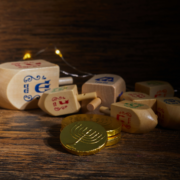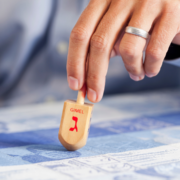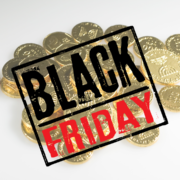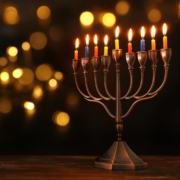Using Corn and Hanukkah as Educational Tools
As originally appeared in The Jerusalem Post on December 2, 2023.
‘Farming looks mighty easy when your plow is a pencil and you’re a thousand miles from the cornfield,” former US president Dwight D. Eisenhower once said.
One night last week my beloved wife cooked up some sweet corn. It was unanimous that this was the best corn any of us had ever eaten. I must apologize to my father, he should be well, who used to grow corn in our garden. That was good, but this was on another level.
The next day, I went shopping at Mahaneh Yehuda market, and there were beautiful ears of corn everywhere. I mentioned to my daughter how gorgeous the corn looked and how thick the husks were. She just looked at me like I was nuts. Well, it turns out that thick corn husks have a special meaning.
For some reason that I won’t get into, I Googled “corn.” It turns out that according to the Farmer’s Almanac, “Thicker than normal onion skins or corn husks” are a sign of a hard winter ahead. Who would’ve known?
It’s hard to imagine that winter is here. We have been so consumed with war, hostages freed, ceasefires, and terrorist shooting attacks that it’s as if time has stopped. Who would’ve thought that this coming week marks the start of Hanukkah? I guess bakers are aware of what time of the year it is. Walk by any bakery and they are already peddling their full menu of Sufganiyot.
As has become customary, I am going to repeat a theme that I write about every year, and that’s how we should use Hanukkah to teach children about responsible money habits.
It was just last week that consumers around the world were blitzed with Black Friday advertisements. We were urged to whip out our plastic and start shopping because, well, everything is on sale. Do you need the item? Can you afford it? Hey, it doesn’t matter; it’s a Black Friday doorbuster and you can always pay with credit.
The proximity of this global shopping spree with Hanukkah can serve as a reminder of how we must educate our children – maybe ourselves as well – concerning money. Children are confronted with some very negative messages regarding money. Spend money, buy things, and you will have happiness. We are continually sold the fantasy that more and more things bring bliss. But it just isn’t true. More “things” don’t equal more happiness.
We need to fight against this prevailing culture of fiscal irresponsibility and teach our children money’s proper role. Start teaching by using the message found in Hanukkah gelt!
What does it teach?
There are many opinions as to Hanukkah gelt’s function. According to Magen Avraham, the custom of giving Hanukkah gelt enabled the poor to get the money needed to buy candles without feeling shame.
I have another answer. The concept of giving Hanukkah gelt is conveyed in a passage in the Code of Jewish Law (Shulchan Aruch), where it states: “It is forbidden to derive any benefit from the lights of the Hanukkah menorah… even to use the light to count your money.”
We may ask why the phrase, “count your money,” is used here specifically. The reason for this is found within the word Hanukkah, which is the root of the Hebrew word chinuch, education. Hanukkah is a time when we celebrate the Jewish people prevailing over the Greek Hellenists, who sought the spiritual destruction of the Jewish people.
Today’s culture is based on consumerism and instant physical gratification, and it is as much of a threat to our existence today as Hellenism was to the Jewish people. Our culture’s symbol is money.
A child needs to know where the money comes from. To a child, it seems as if money is always available. When their parents run out of money, they simply go to a small machine in the wall, punch in a few numbers, and take out even more money. It’s magic.
It’s even worse when the child sits next to a parent deciding what to buy online. In such a case, forget about taking cash out of a wallet, even if the credit card doesn’t come out. It’s as if you are buying something for free. There is no concept that things cost money.
For this reason, the first thing to tell our children when they receive Hanukkah gelt is to give charity. Then, we should talk to them about saving. Ask your child what she would like to use her money for. If she wants to buy an Xbox or a cellphone, explain that she should save up her money. Children need to understand that money is earned through honest, hard work. With older children, long-term savings can be discussed. Money earned from babysitting or other work can be invested, for instance.
We give Hanukkah gelt to educate our children on the importance of giving charity and doing good deeds. They need to learn that this money should be used for constructive purposes and that the pursuit of money for its own sake is not the point of our existence.
Teaching our children good money habits is a good way to beat back the forces of the modern-day Hellenists and internalize Hanukkah’s message.
May all the families of the fallen be comforted. May the hostages be released. May the injured have a speedy recovery. May our dear soldiers be safe and protected.
The information contained in this article reflects the opinion of the author and not necessarily the opinion of Portfolio Resources Group, Inc. or its affiliates.
Aaron Katsman is the author of Retirement GPS: How to Navigate Your Way to A Secure Financial Future with Global Investing (McGraw-Hill), and is a licensed financial professional both in the United States and Israel, and helps people who open investment accounts in the United States. Securities are offered through Portfolio Resources Group, Inc. (www.prginc.net). Member FINRA, SIPC, MSRB, SIFMA, FSI. For more information, call (02) 624-0995 visit www.aaronkatsman.com or email aaron@lighthousecapital.co.il.





